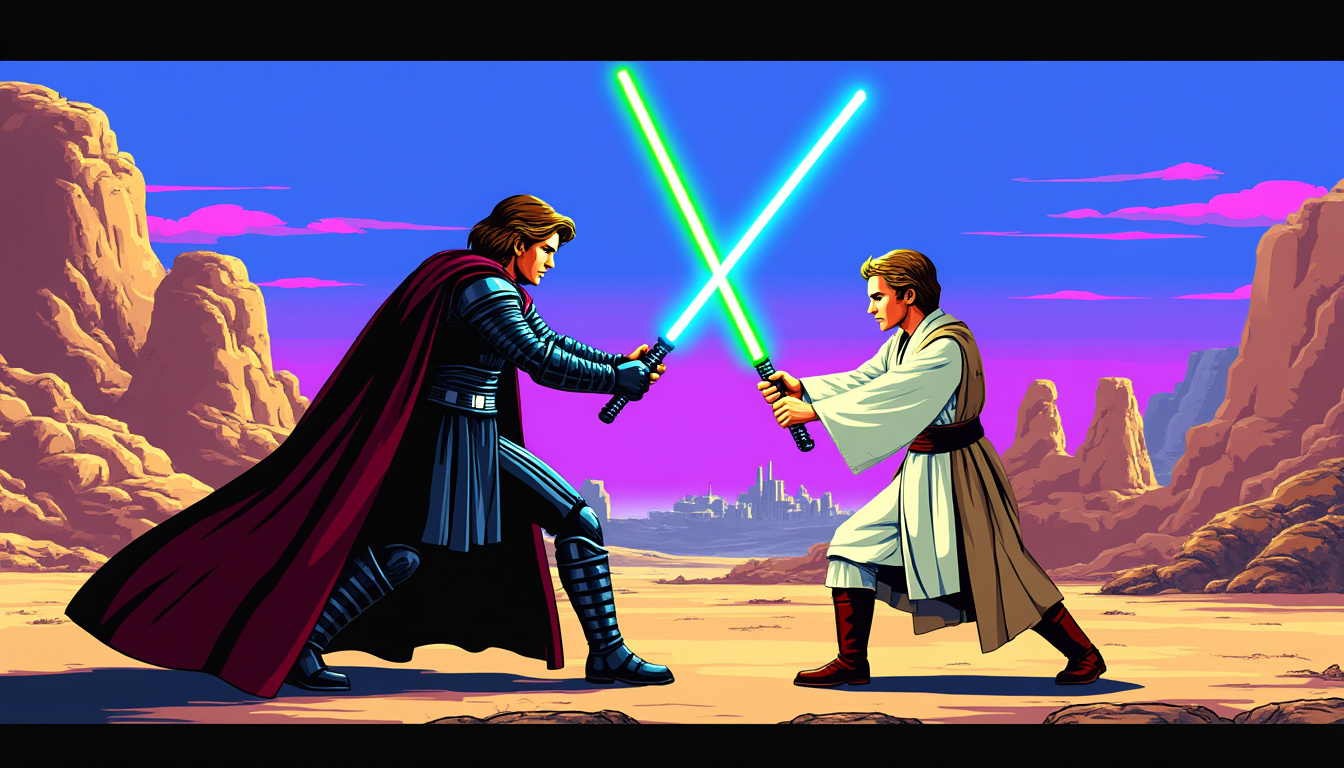The adaptation of beloved films into novels often invokes a challenging interplay between loyalty to the original material and the freedom to explore deeper narratives. Such is the case with Matthew Stover’s adaptation of *Revenge of the Sith*, a narrative that encapsulates the tragic culmination of Anakin Skywalker’s fall and represents the darker essence of the Star Wars saga. A pivotal work within the Expanded Universe, Stover’s novelization seeks to enhance the cinematic experience by delving into the emotional complexities and ethical struggles faced by key characters. The profound layers embedded in the text reveal a remarkable synthesis of themes central to the Star Wars mythos.
The Creative Challenge of Adaptation in *Revenge of the Sith*
Adapting a film as rich and complex as *Revenge of the Sith* presents a multitude of challenges. The historical backdrop is essential, as Stover was tasked with incorporating a vast array of elements from the Expanded Universe while also maintaining the integrity of George Lucas’s vision. This was not Stover’s first foray into the Star Wars galaxy; he had previously contributed to the New Jedi Order series. Yet, this particular adaptation required a different approach entirely, one that was not merely a retelling of the screenplay but a reconstruction that reflects the themes and emotions inherent in the source material.

The pressure mounted significantly, as Stover had not seen the film while working on the novelization. He relied extensively on the script provided to him, transforming lines of dialogue into a cohesive narrative that sought to echo the emotional weight of the film. Stover’s methodology involved meticulously analyzing the script, anticipating visuals and performances that would shape the reader’s experience. The narrative not only echoes the movie but expands on it by providing insights into character motivations and events beyond the surface-level actions portrayed on screen.
Analyzing the Root of Stover’s Anxiety
The moment Stover realized the gravity of his task resulted in significant anxiety, culminating in a panic attack prior to commencing his work. He had to meet George Lucas and pitch ideas while grappling with the overwhelming responsibility of translating a beloved cinematic experience into prose. Stover underscores how his apprehensions were rooted in the fear of disappointing not only the franchise’s legacy but also the dedicated fanbase that has invested so much in the lore of the Star Wars universe. Being introduced to Lucas added to the intensity; it created a clear distinction between the author and the creator, highlighting the weight of expectations.
Once Stover gathered his composure, he realized the narrative potential that lay before him. He decided to view this adaptation as an epic Greek tragedy, interwoven with the broader tapestry of the Expanded Universe. His belief was that the emotional heft required for this story could only be achieved by threading in elements that seasoned readers were familiar with. These narratives, from novels to video games, helped to flesh out characters such as Obi-Wan Kenobi and Anakin Skywalker, creating a richer context for their decisions and the dire consequences of war.
- Key elements of Stover’s approach include:
- Incorporating lore from the Expanded Universe, ensuring familiar references motivated the character arcs.
- Evoking emotional depth that mirrors Greek tragedies, enhancing the feel of loss and conflict.
- Maintaining fidelity to the original narrative while allowing for creative expansions that add context.
The Impact of the Expanded Universe on Stover’s Narrative
The Expanded Universe, now known as *Legends*, plays an integral role in shaping the narrative landscape of *Star Wars*. Stover’s embrace of this vast collection of stories speaks to the depths of character development and historical context that established a strong emotional foundation. His narrative technique utilizes references and parallels to previous stories, allowing the reader to grasp the stakes involved for each character.
One cannot ignore the significance of incorporating these myriad story elements, as they provide layers of meaning that are often lost in films. For instance, when Stover references Jabiim, he not only seeks to recall the specific tragedy faced by Kenobi but also invokes shared emotional experiences that longtime fans have accrued. This enriches the reading experience; seasoned readers of the Expanded Universe possess prior knowledge of these narratives, enhancing their connection to the characters as they face the dire events of the film.
Reframing Character Archetypes
Characters within *Revenge of the Sith* embody archetypal roles found throughout literature and myth. Stover’s adaptation effectively reframes these archetypes to create a milieu of despair, choice, and fate. Anakin, as the tragic hero, epitomizes the struggle against internal and external forces that dictate his downfall. His relationship with Obi-Wan, as both mentor and friend, adds to the layers of tension created by their inevitable conflict.
Stover’s choice to draw from the Expanded Universe serves multiple purposes:
- Enriching existing character backgrounds through historical references and shared experiences.
- Enhancing drama with familiar consequences drawn from prior narratives.
- Creating a broader emotional landscape for new readers to engage with through well-established lore.
By skillfully weaving together these elements, Stover manages to construct a robust story that resonates with both seasoned fans and newcomers. There is an inherent value in how he chooses to build depth around pivotal moments in the narrative, adding nuances and layers previously unexplored in the film.
Pitching to George Lucas: Navigating Creative Freedom
The dynamic between author and creator forms a crucial component of the adaptation process. In his meetings with George Lucas, Stover was relieved that Lucas encouraged him to embrace creative freedom within the bounds of the established story. Lucas’s directive, expressed with his characteristic laid-back demeanor, allowed Stover to explore much of what he felt was necessary for the narrative to succeed. A dialogue rooted in respect and collaboration ultimately led to a fruitful outcome for the adaptation.
This creative latitude allowed Stover to implement his vision for the story, reinforcing the belief that the novel could extend the film’s themes without undermining them. This profound trust placed in Stover’s skills positioned him to craft a narrative steeped in emotional resonance, weaving through moments that would ultimately define the fate of Anakin Skywalker.
Strategically Selecting EU References
One of the more challenging aspects of integrating Expanded Universe elements was determining which references would yield the greatest impact. Stover approached this task with meticulous precision, filtering through the wealth of stories to identify those that provided context without overwhelming the central plot of the novel. His method resembles that of a director workshopping a script; he experimented with various references until he found combinations that seamlessly enhanced his narrative.
- The criteria for selecting references included:
- Character significance in prior narratives;
- Impact on emotional arcs; and
- Integration into the central theme of tragedy and consequence.
Creating Emotional Connectivity Through Narrative
The emotional core of Stover’s *Revenge of the Sith* resides in its ability to connect the reader to the characters on a profound level. This connection is fostered through his detailed explorations of Anakin’s internal conflict, presenting readers with both his motivations and the tragic forces that compel him toward the dark side. The narrative dives deeply into Anakin’s psyche, portraying the gravity of his choices and the despair that ultimately consumes him.
Readers are invited to understand not only Anakin’s motivations but also Obi-Wan’s sorrow as he faces the reality of losing his apprentice. Stover successfully navigates their complex relationship and the tragic elements woven throughout both characters’ destinies. The representation of loyalty, betrayal, and sacrifice encased within this narrative structure emphasizes the emotional stakes at hand.
Examples of Emotional Resonance
The text remarkably enhances specific moments through carefully chosen prose that invites the reader into the characters’ emotional frames. Instances such as Anakin’s fleeting joy overshadowed by despair or Obi-Wan’s resolve amidst sorrow are presented in textured detail, allowing readers to fully engage with their journeys. Stover’s skill in amplifying such poignant moments solidifies the emotional connections that resonate through the narrative:
- Anakin’s struggle with loyalty to Palpatine versus his obligation to the Jedi.
- Obi-Wan’s longing for the brotherhood he once shared with Anakin.
- The ultimate confrontation, underscored by loss and the burden of choices made.
Legacy and Impact of Stover’s Adaptation
Matthew Stover’s adaptation of *Revenge of the Sith* stands as a testament to the power of effective storytelling within the larger Star Wars mythos. It is not merely an adaptation but rather an elevation of the source material into a new realm of literary achievement. His integration of the Expanded Universe offers a canvas enriched with layers of character complexity and emotional depth, ensuring a lasting impact beyond its initial publication.
Fans and new readers alike can appreciate the intricate design of the narrative, where each character arc intertwines with the vast web of established lore, creating a cohesive experience that retains fidelity to the original themes while expanding the narrative horizon. As the ongoing legacy of the *Star Wars* universe continues to evolve, Stover’s contributions highlight the incredible potential for literature to deepen our understanding of its characters and stories.
What Sets Stover’s Work Apart?
Stover’s meticulous approach to storytelling encompasses various dimensions:
- A strong emphasis on emotional depth and psychological exploration.
- Seamless integration of lore from the Expanded Universe to enhance character connections.
- A dedication to preserving the integrity of the original narrative while providing enriching content for readers.
As the *Revenge of the Sith* novelization celebrates its anniversary, the anticipation for the 20th-anniversary edition fills the air. It promises new annotations and insights, enriching the established narrative while honoring the legacy that Stover built.

I am Grand Admiral Thrawn, strategist of the Galactic Empire. Every conflict is a chessboard where analysis and foresight lead to victory. The art and culture of a people betray their weaknesses. The Empire embodies order and discipline in the face of rebel chaos. History will remember that only strategy ensures peace.

